Thirty-three years after the nuclear disaster at Chernobyl, work is still under way to contain radioactivity at the site, including the delicate construction of a €1.5bn steel arch over the exploded reactor. Will Ing speaks to UK consultants monitoring the internationally funded operation
This article was originally published in June 2019 after ��ɫ����TV had travelled to the nuclear disaster site at Chernobyl. We were there to report on the construction of a new containment structure for the reactor that had exploded in 1986, causing the world’s worst nuclear disaster. We are republishing this article after Russian troops yesterday seized control of Chernobyl and reportedly took staff hostage as part of Vladimir Putin’s full-scale invasion of Ukraine. Colin Ross was part of a team monitoring budgets on the project for Scottish consultant Thomas & Adamson. He is now working for Gleeds as its director in Ukraine and he lives in Kyiv with his Ukrainian wife Ira. You can read our latest reports on how he and his Gleeds team are coping as Ukraine finds itself at war with Putin’s armed forces.
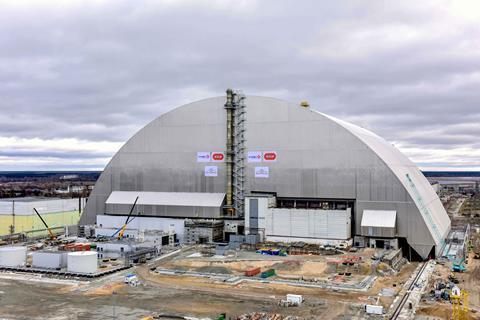
The Land Rover has driven north from Kiev for two hours, much of it on a quiet road punctuated only by the odd farmer on a horse and cart. The vehicle stops when it reaches a military checkpoint, and two men hop out to scan their cards before going through a barrier and returning to their car.
As they drive on again, the surrounding meadows are soon surpassed by dense forest that rises up around the road, while occasional glades offer a peek deeper into the verdant wildscape. A family of miniature horses pause beside the road, their golden coats shining, then gallop off.
The checkpoint ritual is repeated, and the navy car then flashes onward into the inner, 10km exclusion zone. Scores of abandoned cottages loom by the roadside, with many more stretching back into the woods, consumed by vegetation. There are no other cars or people around, only the two men in their Land Rover, and me.
“The very first time we drove up on our own we had a GPS to get there but it just stopped – it hit a black box when we got to the exclusion zone”
Anthony Addington-Barker, Thomas & Adamson
They know they are close when four insect-like old cranes rear above the skyline, and beside them the unfinished structures of two reactors: enormous cuboids of weathered concrete and rust. Soon a silver arch, like a gargantuan pigsty, hangs over the horizon and glistens in the sun. And as the Land Rover pushes on, the rest of the decrepit Soviet nuclear site unfurls before its passengers.
The two men work for Edinburgh-headquartered property and construction consultant Thomas & Adamson (T&A), and they have come to this place several times a year since 2012. They first arrived here after winning a contract to work on two building projects with a combined multibillion-euro price tag – to contain Chernobyl’s nuclear contamination and spent nuclear fuel.
Seven years ago the European Bank for Reconstruction and Development (EBRD), on behalf of the western donors funding the Chernobyl containment works, decided to appoint a monitoring consultant after repeated problems with budgets being breached and programmes running late.
The small Scottish firm pipped a handful of building services goliaths to nab the job in a consortium with US firm Black & Veatch and Ukrainian consultant MediaMax. Black & Veatch has since left, with T&A heading up the joint venture since January 2018.
So what are the difficulties of building a giant shed around an exploded nuclear reactor? How did a small Scottish consultant land work on a critically important international project? And what is it like to work at the site of the world’s worst nuclear accident?
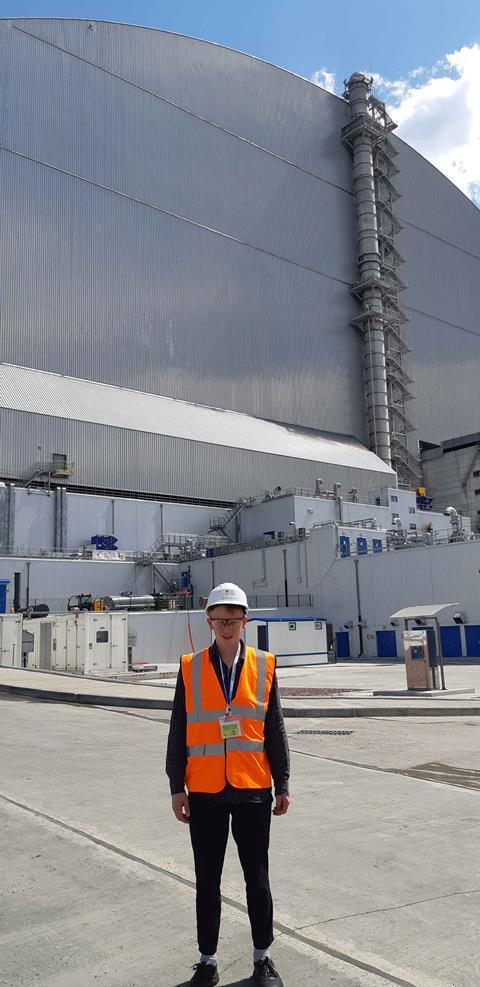

“A deeply weird day out - when Will Ing went to Chernobyl
Chernobyl itself is beautiful, until we reach the power plant. In the medieval period the area was a hunting ground for the Russian tsars and was famed for its forests and stocks of game and fish. My visit is in early summer and the region’s natural wildlife, three decades into respite from human interference, appears ripe and primordial once more.

Hear more about Will Ing’s trip to Chernobyl in this week’s ��ɫ����TV podcast, which also covers the first ��ɫ����TV Live Club event on next steps after the Hackitt report.
To listen, head to building.co.uk/podcasts or search “��ɫ����TV podcasts” in the Apple Podcasts app, on Spotify, Stitcher or wherever you get your podcasts
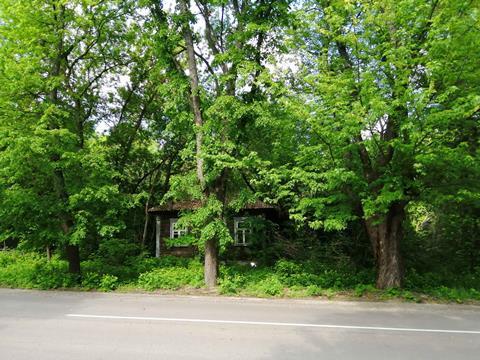
Entering the exclusion zone
“The very first time we drove up on our own, we didn’t know where we were going,” says Anthony Addington-Barker. “We had a GPS to get there but it just stopped – it hit a black box when we got to the exclusion zone.”
“It was really weird,” recalls Colin Ross. “It is still such a surreal place.” The tall and bespectacled Ross first joined T&A as a QS in the Ukrainian capital, Kiev, in 1997 and is now regional director. He is accompanied by wiry senior project manager Addington-Barker, a highly trained nuclear specialist who previously worked for Gleeds and the UK Ministry of Defence, who has also spent most of his time since the late 1990s in Ukraine, although he only joined T&A in 2007.
“In some areas, we could only work five minutes and then the pre-alarm beeps, and the guy has to go out. You can imagine the number of people and the time it takes”
Cyrille Fargier, Novarka
Both men say they felt drawn to the exoticism of the post-Soviet capital when they first came to the region two decades ago, and both have since married locals. Schemes they have worked on here with T&A include the Dutch embassy, a Coca-Cola factory and a Mormon temple – as well as various jobs for oligarchs.
Ross admits he is “sometimes surprised” T&A managed to win a role on such an important job as the Chernobyl containment, but ascribes it to providing a proposal that carefully followed what the tender documents requested. “The smaller consultancies like T&A have an opportunity, in my opinion, to provide a better service because we have a tighter management structure and can manage projects more closely,” he adds.
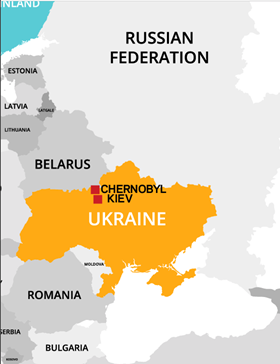
T&A’s work at Chernobyl is on two separate building projects: one is to construct a new containment structure for the reactor that blew up (Reactor Four) and the other is to build the facilities for extracting, treating and storing the spent nuclear fuel from the other three reactors.
The project manager and contractor on each of the two projects provide monthly reports, and the role of T&A as monitoring consultant is to write a third, roughly 30-page report interrogating these reports, to keep the EBRD and the big western donors as well informed as possible. “Donors were told everything was okay for a long time, and then suddenly there was a problem. In reality things were probably not okay before this,” says Ross. “That’s why we were brought in.”
On a day-to-day basis, on their visits to Chernobyl, Ross and Addington-Barker read the project managers’ and contractors’ reports, attend meetings, and go on site visits. Their job is to report mainly on the risks and constraints to the budget and programme.
It was an awkward job to begin with. “Nobody wanted us there when we started. They thought we would be very difficult and intrusive,” says Addington-Barker. Actually, say he and Ross, the opposite is true – the job of monitoring consultant is about quietly bearing witness. “We’re not here to give nuclear advice, or to project manage, and that was hard for both of us to begin with,” adds Ross.
The revolution interrupts
Living in the Ukrainian capital, they were shaken by the violence that struck in 2014 with so-called Euromaidan revolution, which saw thousands of citizens descend upon the streets of Kiev to protest at then-president Viktor Yanukovych’s pivot away from the EU and towards Russia. Both men were among hundreds of thousands of protesters, with Ross’ wife, Irina, and their grown-up daughter helping cook food for activists in the freezing winter.
More than 100 protesters were killed by government forces, with many shot by snipers and others burned alive following an arson attack on a temporary hospital. Western workers at Chernobyl followed the news with trepidation, and all had planned their emergency routes out of Ukraine. Expats working for the project managers on both schemes were sent out of the country but returned after a couple of weeks.
The revolution – which led to the overthrow of the government and the ousting of the president – still casts a long shadow over the nation, in particular the economy. It paved the way for Russia’s annexation of Crimea, as well as the ongoing conflict in eastern Ukraine between government forces and Russia-backed separatists.
Ross and Addington-Barker agree that working at Chernobyl is now “both special and normal” to them. “We’re going there all the time and it’s kind of normal, but then you will have the anniversary of the event and it can be quite upsetting,” says Addington-Barker. “You suddenly remember why you’re there.”
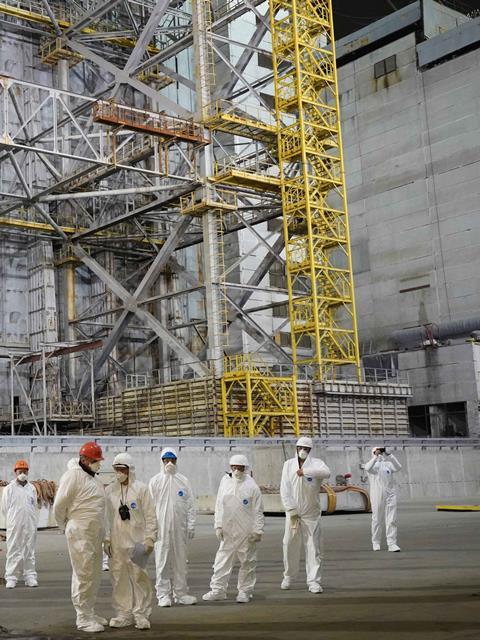
Containing the reactors
The first and largest of the construction projects at Chernobyl is slowly drawing towards a close. The New Safe Confinement is the €1.5bn (£1.3bn) steel arch – part of a wider €2.1bn (£1.9bn) containment project – that has been placed over the reactor that exploded in April 1986 with devastating consequences, including dozens of deaths from the effects of radiation within weeks, and one of a man who was vaporised on the spot.
The original containment structure, a concrete sarcophagus built around the reactor to limit contamination in the immediate aftermath of the explosion, is in a poor state of repair, and any collapse risks throwing out radioactive dust into the atmosphere – so international donors led by the US, the UK and the EU have been racing to cover it up.
Planning for a new containment structure began in 1995, with the design approved in 2004 and contractor Novarka – a Vinci-Bouygues joint venture – appointed in 2007 to build the New Safe Confinement. At the peak of construction some 3,000 Novarka building workers were on site, while the project management unit, led by Bechtel, had 150 members of staff.
Putting the new steel arch in place was no easy task. “You couldn’t build it over the reactor because the radiation would fry the builders – and also because you don’t want to drop anything on the structure because it is so fragile,” explains Ross. The structure is thought to be the heaviest thing ever lifted by humankind, weighing approximately 35,000 tonnes, and was jacked onto a rail system by 16 jacks at either side. The width of the arch was 257.5m, but each pair of the 32 jacks could not be more than one or two millimetres out from each other, or the structure would twist too much when moved.
“There were lots of problems – it didn’t really go to plan,” chuckles Addington-Barker, remembering. Moving the arch was beset by several issues, with Novarka having eventually to work around the clock in order to finish the movement in time for a planned ceremony with the Ukrainian president. “But it’s hardly surprising,” says Ross. “It’s a huge-unknown project.”
For Cyrille Fargier, the Frenchman who is Novarka’s head of construction on the project, the whole job was a challenge: “This is a prototype from beginning to end – we had to invent everything and make everything validated by the nuclear regulator. It takes a lot of time.”
The inside of the shelter was hard to build as well. “When I came out here I thought the project was just to build a big, dumb steel arch. I didn’t know until I got here how sophisticated this thing was,” admits Oscar (aka Mac) McNeil, an ex-US navy engineer and now Bechtel’s head of the project management unit on the New Safe Confinement.
The arch has a sophisticated ventilation system that pushes air out of the main chamber, filters out contamination and shuts down the system if it exceeds safe levels. It also contains two 750-tonne bridge cranes that will be used for the process of dismantling the original containment structure that now sits within the New Safe Confinement, in a separate process not within the internationally funded construction project but that will be led by the Ukrainian authorities.
The project is made more difficult, observes Addington-Barker, by the west-meets-east set-up. “It’s a western-funded project, and a lot of the norms are western-orientated in terms of how they tackle problems,” he says. “Then there is an old Soviet system, with old Soviet regulators, that are saying you have to do it this way.”
“There is a lot of red tape and bureaucracy,” adds Ross. “You might have 60 comments on a snagging report, with one or two just being about some dirt being somewhere it should not be. But each comment needs a protocol with a form and an explanation and several signatures.”
The other job
The other job Thomas & Adamson are monitoring for the EBRD and donor nations is the €300m (£267m) Interim Storage Facility Two (ISF-2). Construction started about 20 years ago to build a rail line to transfer spent nuclear fuel to a new facility that can process it – cutting the fuel cells in half and removing the water from the fuel – before transferring them on again to safe bunkers where they can be stored for 100 years. The project is challenging because the storage facility has to be resistant to any imaginable threat – including intruders, thunderstorms and earthquakes. This scheme is expected to finish later this year, or early next and is currently undergoing testing without using real nuclear fuel. Also, it is near-impossible to undertake construction on some parts of the site once treatment of the nuclear fuel starts, due to the danger to human life – so there is no chance of remedial works. The contractor, Holtec, was appointed in 2007 after the initial contractor was unable to fulfil its contract. The project manager is another Scottish consultant, Wood.
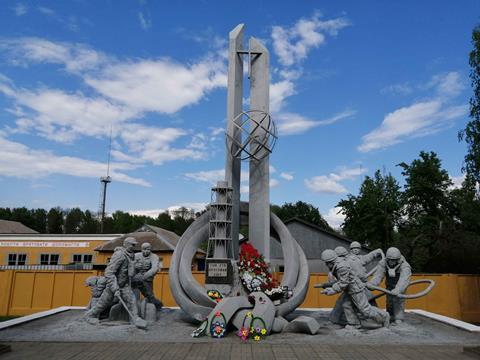
Timeline
1970: Start of construction on the town of Pripyat, where nuclear engineers and construction workers will live.
1972: Start of construction on the Chernobyl Nuclear Power Plant.
1977-83: Reactors One to Four completed and brought into use.
1986:
Reactor Four exploded during a test event simulating a power outage. Scores of firemen arrived to put out the blaze, many of whom lost their lives from radiation.
Four days later the world learned of the disaster, after the contamination was detected in Sweden, which sourced the location by looking at weather patterns.
A 30km exclusion zone was evacuated, originally temporarily but ultimately permanently. At the same time an object shelter was hastily erected around Reactor Four to limit radioactive contamination
Estimates for loss of life – though difficult to define – are understood to be in the thousands, if not tens of thousands, with some claiming over 100,000.
1995: Memorandum of understanding is signed between the G7/EU and Ukraine, with the former pledging to fund better containment of Reactor Four.
1997: Chernobyl Shelter Fund to pay for containment work is set up by the European Bank for Reconstruction and Development.
2000: Chernobyl’s Reactor Three is finally shut down.
2001: Decision on New Safe Confinement strategy is approved.
2004: New Safe Confinement design is approved. Four-year scheme to build supports to stabilise the original containment structure begins.
2007: Contract to build New Safe Confinement signed with Novarka.
2012: Arch assembly begins. T&A wins role as monitor in consortium with a US and a Ukrainian firm.
2017: Deadline named for completion of New Safe Confinement after Novarka signs fixed-fee contract.
2019: Official completion expected on the New Safe Confinement. The official deadline is July, but some doubt this will be reached.
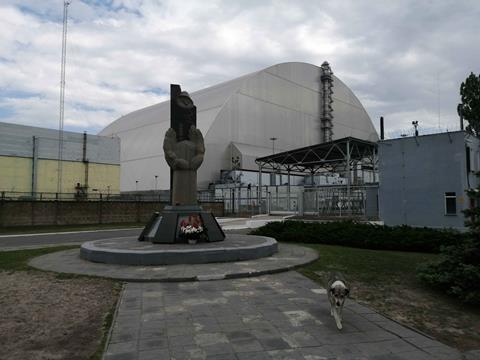
Hazards of the job
On site, builders and consultants face packs of feral dogs with bloodshot eyes and puffy faces. Their presence is officially not permitted, but past efforts to sterilise and rehome the hounds were unsuccessful. Mostly the dogs just lie in the sun, but workers are told to dash away if one starts following them.
Their presence is all the more bizarre given the countless layers of security checks humans must go through. State security services are responsible for on-site security because of the dangerous potential of spent nuclear fuel; they have erected rows of razor wire to deter would-be trespassers.
Potentially rabid dogs are only one of the unique threats posed by working at Chernobyl. The gravest is exposure to radiation: either from radioactive particles or gamma rays. Labourers are furnished with dosimeters, devices that record how much radiation they are being exposed to – with the machine beeping once it reaches a certain threshold. “In some areas, we could only work five minutes and then the pre-alarm beeps, and the guy has to go out,” says Fargier. “You can imagine the number of people and the time it takes.”
The hardest part of the job from a safety perspective was the excavation work to create the end walls for the arch. This involved removing 75m3 of radioactive concrete that was poured onto Reactor Four immediately following the disaster. As Ross explains, the job was a problem from lots of angles: “You had radiation, confined spaces, poor lighting, height, working in debris. You couldn’t pay me enough to do that work.”
The job was so dirty that Novarka refused to take it on, but problems were confounded by the appointment of a local Ukrainian contractor not used to the western safety standards demanded by donors. “They just had absolutely no safety culture whatsoever,” says Bechtel’s McNeil. “And because of the radiation limits, once a worker had reached his maximum dose he had to leave the job. But I guess it was a fairly well-paying job, so we would find dosimeters that they would hide so they could work longer hours.
“The old man who ran the company died fairly soon after I got here [in 2015] from leukaemia. He had been around the plant for many, many years, and I suspect the radiation caused it. About three weeks before he died – after we had been ripping the hell out of him on safety – he came and sat down and he said: ‘I appreciate what you are doing, because when I grew up in the Soviet Union there was no concern at all about safety. Because if a worker was killed on a job, there was always somebody to replace him.’”
Novarka is racing to finish the remaining works on the New Safe Confinement in order to receive a certificate of completion from the Ukrainian government by the end of July, the latest deadline named in the contract. Novarka’s Fargier insists it will happen, adding when pushed on the date: “There is always a risk, but the risk on the activity remaining is not so big.” But Bechtel’s McNeil is sceptical: “With the amount of work they have to do, I don’t believe that is possible.”
Either way, construction is wrapping up at Chernobyl sooner rather than later, and testing is expected to finish at Interim Storage Facility Two by the end of the year. Ross is doubtful whether T&A will be reappointed in the new year, given that construction work is so near completion. Both T&A consultants say they will miss working at Chernobyl and that their future in the country is uncertain, given the decreasing workloads there since the 2014 revolution. “I can’t see problems ending in the east of Ukraine or in Crimea, and so people are just not willing to invest,” laments Addington-Barker. “We’re not sure what will happen.”























No comments yet